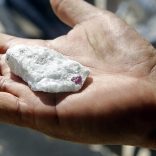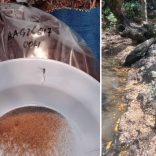Galp and AIESEC launch training program for young Mozambicans
Minor discrepancies reported in latest EITI report – AIM

Map: Voa Portugues
The difference between the payments to the Mozambican state reported by mining and hydrocarbon companies in 2017 and the payments which state bodies say they received was 1.2 per cent in 2017, and the discrepancy fell to 1.04 per cent in 2018.
The figures from the eighth report on Mozambique under the Extractive Industry Transparency Initiative (EITI), published in Maputo on Friday show a discrepancy in 2017 of almost 477 million meticais (about 7.32 million dollars), which is 1.22 per cent of the amounts confirmed by the state.
This discrepancy is mostly in the mining sector (476.2 million meticais), with a discrepancy of only 715,000 dollars in the figures reported by hydrocarbon companies.
For 2018, the overall discrepancy detected was 190.8 million meticais, about 1.04 per cent of the revenue reported by the state.
ALSO READ: EITI report shows differences in payments and receipts in extractive industry in Mozambique
There is, as yet, no explanation for the discrepancies. Neither the companies in the extractive industry, nor the Mozambican Tax Authority (AT) sent clarifications before the report was submitted.
Mozambique joined EITI in 2009. The Initiative’s website describes EITI as “the global standard to promote the open and accountable management of oil, gas and mineral resources”. Countries that sign up to the initiative must disclose information about the extractive industry value chain “from licensing to extraction, to how revenue makes its way through to government, to how it contributes to the economy and wider society”.
Key to this is reconciliation of how much the companies say they have paid to the state, and how much the state authorities say they have received.
The EITI Principles declare that “a public understanding of government revenues and expenditure over time [can] help public debate and inform choice of appropriate and realistic options for sustainable development”. EITI member countries are required to submit reports that are “comprehensible, actively promoted, publicly accessible, and contribute to public debate”.
Discrepancies in the reconciliation have occurred in previous EITI reports. Thus in the report covering 2015 there was a discrepancy of 38.2 million meticais, or about one per cent of the total revenue reported by the state. For 2016, covered in the same report, the discrepancy fell to a negligible 0.01 per cent.
The discrepancies are not all in the same direction. When the figures are broken down, company by company, in some case the payments reported by the companies are less than the payments acknowledged by the state, and in other cases more.
The discrepancies for 2017 and 2018 are not considered “material” by EITI. The threshold for “materiality” is a three per cent difference between what companies claim to have paid and what the state says it has received.
The latest report puts the contribution of the extractive industry to Mozambique’s Gross Domestic Product at 6.86 per cent in 2017 and 7.35 per cent in 2018.
The Minister of Mineral Resources and Energy, Max Tonela, told reporters attending the Friday ceremony “this is an exercise we carry out every year. Our perspective is to work to make ever more transparent the way in which the State uses the resources it receives from the activity of the extractive industry”.













Leave a Reply
Be the First to Comment!
You must be logged in to post a comment.
You must be logged in to post a comment.